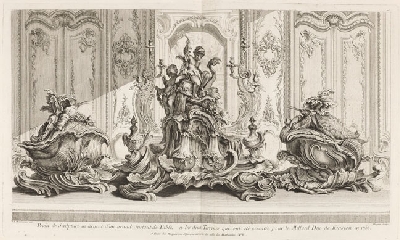Juste Aurèle Meissonier (1695–1750)
Juste Aurèle Meissonier (1695–1750), an Italian who came to Paris in 1723, was a goldsmith, sculptor, painter, architect, and furniture designer. He is often considered the leading originator of the influential Rococo style in the decorative arts. Described by one of his contemporaries as "an unruly genius, and, what's more, spoilt by Italy."
Biography
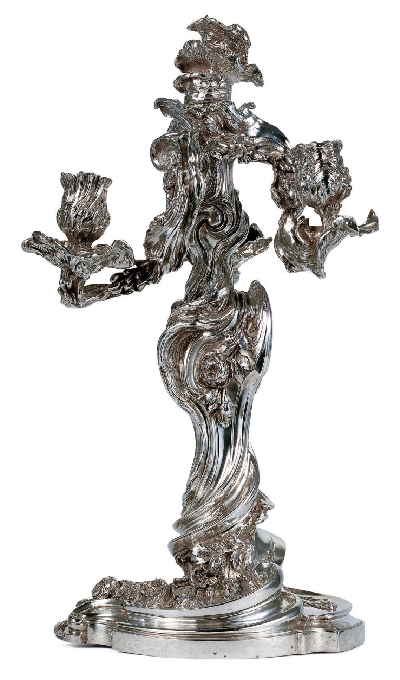 Candelabre made by Juste Aurèle Meissonier and Claude Duvivier, 1734Juste-Aurèle Meissonnier was born at Turin (Torino) on March 17, 1695, the son of Etienne Meissonnier II (b.1660) a goldsmith from Aix-en-Provence, France.
Candelabre made by Juste Aurèle Meissonier and Claude Duvivier, 1734Juste-Aurèle Meissonnier was born at Turin (Torino) on March 17, 1695, the son of Etienne Meissonnier II (b.1660) a goldsmith from Aix-en-Provence, France.
Young Juste-Aurele's first recorded commission was for the engraving of dies for the Turin Mint. And his second, in 1715, for a medal die for the French Royal Mint.
His Italian origin and training were probably responsible for the extravagance of his decorative style. He shared, and perhaps distanced, the meretricious triumphs of architects, Oppenard and Germain Boffrand (1667—1754), since he dealt with the Rococo in its most daring and flamboyant developments.
From this time he lived in Paris, by 1718 or 1719 being described as a "cizeleur' and a "dessinateur," living on the Ile de la Cité.
In 1723, we see his developing career as a professional craftsman and draughtsman-designer established with a remarkable wine cooler executed for the younger Louis de Rochechouart, Duc de Mortemart(1636-1688). This important patronage allowed Meissonnier to obtain a workshop in the Manufacture des Gobelins (Gobelins Manufactory).
In 1724, he joined the Paris company of goldsmiths and was granted permission to designate himself "orfevre du roy (goldsmith for Louis)" from Louis XV (1710-1774).
In 1726 his appointment as designer for the king's bedchamber and cabinet (Dessinateur de la chambre et du cabinet du roi) solidified his position.
The year 1729 found Meissonnier devising a huge fireworks display for the forecourt of the Palace of Versailles to commemorate the birth of the Dauphin.
At this same period, if not before, Juste Aurèle Meissonier began designing and modeling for porcelain producted at Manufacture de Porcelaine at Chantilly, under patronage of Duc de Bourbon (Prince de Condé). Meissonnier's first essays in the genre were for his patron the Prince de Condé. Manufacture de Porcelaine at Chantilly was founded in 1725 by Ciquaire Cirou (ca.1700-1751), under the patronage of Louis-Henri, Prince de Conde, as appears by a letter patent. Condé was an avid collector of East Asian porcelains, both Chinese and Japanese, and his Chantilly manufactory's first decade of output showed the marked influence of Arita porcelain, particularly in the "Kakiemon" palette of soft iron red and blue-green. A patent granted to the factory in 1735 by Louis XV specifically describes the right to make porcelain façon de Japon, "in imitation of the porcelain of Japan;" its reference to ten years' successful experiment on the part of Ciquaire Cirou is the basis for dating the factory's origins to 1725, found in many sources. The factory had developed its own whimsical interpretations of Asian motifs, combining an exotic dragon and monkey with European flowers. The Chantilly pattern was a great favorite for ordinary services, also called Barbeau, a small blue flower runnning over the white paste.
The artist's multifarious activities extended from designing silver and goldsmiths' work, snuff boxes, gilt bronzes, ornament, picture frames, interior decorations, furniture, coaches and sledges, to painting and architecture.
Although qualified to practice as a goldsmith, Meissonnier seems to have concentrated on providing drawings of objects designed with flowing scrolls, asymmetrical foliage and dripping water motifs, many of which were also engraved. His personal involvement with the actual execution of objects is still unknown, but he was probably commissioned to produce designs that were then made in gold or silver by another silversmith.
Meissonnier embraced the new Rococo style with enthusiasm. Taking its name in the nineteenth century from the word rocaille, originally meaning irregular forms found in nature, a characteristic of the style was to impart a sense of movement to the design of an object. This was ahieved by the use of convex and concave shapes, serpentine contours and spiral flutes.
Meissonnier provided designs for a variety of clients including the French court and church as well as English, Polish, and Portuguese nobles. He produced works of astonishing variety: paneling for rooms, picture frames, tables, chairs, snuffboxes, lanterns, crucifixes, clocks, and even a project to celebrate the wedding of Louis XV's eldest daughter, which included an elaborate architectural setting for the fireworks display.
When the wealthy young Duke of Kingston (1712-1773) approached Meissonnier with a commission in 1734, the artist was at the height of his powers. Able to boast considerable experience in all aspects of the arts, from designing and making models and casts to chasing, he was also well used to subcontracting and working with skilled craftsmen on the execution of his designs and models.
Rarely does he leave a foot or two of undecorated space; Meissonier carried the style of his day to its extreme and thus achieved great popularity. His work in gold and silver-plate was often graceful and sometimes bold and original. He was least successful in furniture, where his twirls and convolutions, his floral and rocaille motives were conspicuous.
2 Tureens for Evelyn Pierrepont, 2nd Duke of Kingston, by Meissonnier in 1734/35
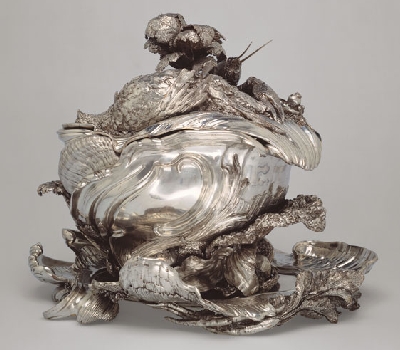 A Silver Tureen, Stand and Cover designed by Juste-Aurèle Meissonnier, executed by Pierre-François Bonnestrenne and Henry Adnet, Paris, 1735-1740. (36.9 by 45.6 by 38 cm.)The best illustration of the impact of Rococo design in silver are the two tureens created for Kingston by Meissonnier in 1734/35.
A Silver Tureen, Stand and Cover designed by Juste-Aurèle Meissonnier, executed by Pierre-François Bonnestrenne and Henry Adnet, Paris, 1735-1740. (36.9 by 45.6 by 38 cm.)The best illustration of the impact of Rococo design in silver are the two tureens created for Kingston by Meissonnier in 1734/35.
In his introductory essay for the catalogue in this present sale, Dr. Peter Fuhring explains that the artist began each of his models for this commission with a real sea shell, turning it into the vessel's body. The shape of the lid is likewise adapted from a shell, upon which the animals and vegetables are placed to harmonize with the oval tureen and its platter. The latter itself becomes a perfect example of an asymmetric cartouche, of which the underside is perhaps even more remarkable than the upper. Vegetables are integrated into the platter's undulating border of concave and convex forms. When assembled, the three elements of platter, tureen and lid create a completely novel effect: a harmonious and balanced whole, without beginning or end.
Each tureen bears Meissonnier's engraved signature in acknowledgment of his responsibility for both its design and execution. For the actual making of the tureens Meissonnier employed two Parisian silversmiths, Henry Adnet (1683-1745) and Pierre-François Bonnestrenne (1682?-after 1740).
"Meissonier's Kingston tureens encompassed all the latest technical achievements, social vogues and aesthetic innovations," writes Ubaldo Vitali in the same catalogue. "They are very complex equations of their time and place. Their coefficients, variables and quantities are totally interconnected and should not therefore be analyzed independently. For instance, his use of natura which in some cases was actually molded from life, cannot be understood outside of the social fashions and scientific interests of the early eighteenth century, just as the full impact of his invenzione can only be appreciated within the context of the intellectual history of the 1730s in Paris.
"The Kinston tureens," concludes Vitali, "encapsulate the many complex facets of Meissonnier's persona. They are the creation of one of the most innovative minds of the time. In his hands art and technique worked together for a perfect balance and harmony."
One of the tureen was auctioned at Sothrby's in 1998 and Its estimate value was US$8,000,000-12,000,000.
Wall Clock (Pendule à Répétition) designed by Juste-Aurèle Meissonnier, circa 1750
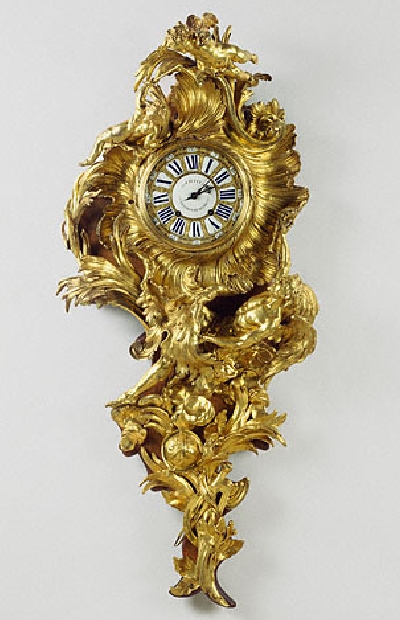 Wall Clock, known as pendules d'alcove (alcove clocks), designed after Juste Aurèle Meissonier, 1735-40. Paul Getty MuseumThe clock's swirling leaves and asymmetrical overall design are typical of the work of Juste-Aurèle Meissonnier, a designer and goldsmith and one of the leading exponents of the Rococo style. In an engraved book of Meissonnier's works, published about 1750, the antechamber wall in a cross-section of a house features a large clock with a reclining figure below the dial positioned like that on the Getty Museum's clock.
Wall Clock, known as pendules d'alcove (alcove clocks), designed after Juste Aurèle Meissonier, 1735-40. Paul Getty MuseumThe clock's swirling leaves and asymmetrical overall design are typical of the work of Juste-Aurèle Meissonnier, a designer and goldsmith and one of the leading exponents of the Rococo style. In an engraved book of Meissonnier's works, published about 1750, the antechamber wall in a cross-section of a house features a large clock with a reclining figure below the dial positioned like that on the Getty Museum's clock.
Such clocks, also known as pendules d'alcove (alcove clocks), were usually small, suitable for hanging in an alcove above a bed. The repeating mechanisms that chimed the nearest hour and quarter hour when a string was pulled eliminated the need to light a candle to see the dial. They also prevented the constant chiming that would awaken a sleeper. This is the largest known example of the pendule d'alcove, indicating that it was made for an extremely imposing interior.
The figures on this clock represent Love conquering Time, a theme often repeated on mid-eighteenth century French clocks. The two cherubs above carry away the scythe and hourglass, the symbols of Time, while Time himself lies vanquished below with his globe, protractor, and pair of compasses.
Bronze and Gilt-bronze Ink Stand by Juste-Aurele Meissonnier, circa 1735
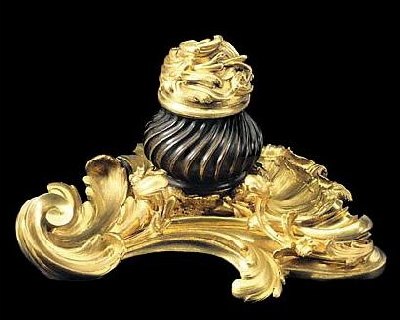 Wall Clock, known as pendules d'alcove (alcove clocks), designed after Juste Aurèle Meissonier, 1735-40. Paul Getty MuseumThe patinated bronze globular spiral twisted inkpot with an acanthus leaf and scroll cast gilt-bronze cover, above a boldly scrolled leaf cast base with running water motifs, acanthus leaves and two foliate and flower cast scrolled pen supports; one pen support re-gilt
Wall Clock, known as pendules d'alcove (alcove clocks), designed after Juste Aurèle Meissonier, 1735-40. Paul Getty MuseumThe patinated bronze globular spiral twisted inkpot with an acanthus leaf and scroll cast gilt-bronze cover, above a boldly scrolled leaf cast base with running water motifs, acanthus leaves and two foliate and flower cast scrolled pen supports; one pen support re-gilt
High: 17cm, WIde: 27cm, Deep: 24cm.
Meissonnier and inkstands
The present encrier, only recently discovered, was unknown within the oeuvre of Meissonnier. It is therefore exciting to be able to add this object to the list of already recorded encriers. There is a model in terracotta for an inkstand which can be attributed to Meissonnier, illustrated for the first time in the article by Dr. Peter Fuhring in Sotheby's New York, The Thyssen Meissonnier Tureen, 13 May 1998, catalogue p. 21, fig 14. That inkstand was created between 1730-1735, probably a few years before the present inkstand. The small holes on the underside of the terracotta encrier indicate that the original intention was to fit the finished porcelain inkstand onto a gilt-bronze base. The present encrier is made in the same spirit with the patinated bronze inkwell sitting on a gilt-bronze base, thus also combining two different materials.
Another inkstand, this time executed in silver, was made by Juste-Aurele Meisonnier in 1731 for the Comte de Maurepas who was Secretaire d'Etat a la Marine. Though the piece itself has unfortunately not survived, the design is known from an engraving of the side view. It is certain that the silver example was executed as it is mentioned in the record of a visit to Meissonnier's atelier by the company of goldsmiths in 1731 and more than likely referred to again in his demande de privilege of 17 November 1733 noting 'Un Dessein d'ecritoire'. This design does not only reveal similarly boldly sculpted scrolls and acanthus motifs, but above all the presence of a virtually identical spiral-twisted patinated bronze inkpot (see fig.1).
Meissonnier and modelling the encrier
The artist almost certainly captured a leaf in a mould as the starting point for creating and shaping the present inkwell. Subsequently from that mould a detailed wax could be made. He then used several of these wax leaves together for his transformation, distillation and recomposition of nature. So once a wax had been poured and extracted from the mould, it could be bent and twisted at the artist's will, beyond nature's will, by slightly heating it in warm water. This explains how in our encrier the coquille, the water motifs and various acanthus leaves turn in space to create perfect imaginary C- and S-scrolls, encompassing all the latest aesthetic innovations. The harmonious orchestration between the rough shell, tactile simulation of water falling, finely chased leaves, rockwork in high relief and bold smooth scrolls on the encrier reflect it's magnificent quality and inventiveness.
The lost wax casting technique
The lost wax casting technique, or cire perdue, was used by Meissonnier not only in his bronzes, but also in his silver pieces. It was a complex process, but one which offered him total freedom in modelling. The very specific final result makes every component appear distinct with a clear separation between the elements. Meissonnier undoubtedly favoured this technique as each demarcation creates undulating shades that play with and counter-balance reflecting areas, enhancing chiaroscuro effects.
The technique consists of making a wax model round a core of burnt clay and enclosing it within an envelope of clay mixed with plaster. The whole is baked and the melted wax runs off through a vent. Subsequently melted bronze is run in to take the place of the wax. The clay envelope can then be cut away and the core broken up inside. The result is a bronze exactly reproducing the original wax model. The technique has the advantage of giving a very fine finish, of allowing the the cast to be taken as a whole and of requiring the minimum of bronze. But it has the disadvantage of allowing only one cast to be taken. Further bronzes can only be obtained by taking a cast of the first one, but of course something of the original's directness is lost with each recast. The sharpness and crispness of the present encrier indicates that it is undoubtedly an original lost wax cast, and in this sense unique.
Meissonnier and gilt-bronze in early 18th century France
There was a great revival of the use of gilt-bronze under the reign of Louis XIV. This probably originated with the installation of a foundry for Domenico Cucci at the Manufacture des Gobelins. This opened the door for Pierre Gole, Philippe Caffieri and Andre-Charles Boulle to expand and develop their use of gilt-bronze. First found as mounts on furniture and around mirrors, artists further embellished their chandeliers, chenets, scientific instruments, accessoires de toilette and carriages with gilt-bronze. After a rather unstable period of melting gold and silver and a decree prohibiting temporarily the production of silver, silver- and goldsmiths were looking for other less precious materials. Gilt-bronze lent itself marvelously to their needs, especially as the end result after the gilding and chasing is virtualy identical in appearance to objects in gold and silver. It is therefore not unusual to find pieces that were originaly conceived to be executed in silver made in gilt-bronze. Little is recorded about Meissonnier's gilt-bronze production, but various examples survived which have been executed in both materials.
By the early 1730's Meissonnier was conscious of how influential and desirable his designs were. Therefore it is thought that he might have sold off some of his drawings and sketches to be executed by other metal-workers. However his own production really stands out next to contemporary objects manufactured by other workshops. The present inkwell is a living proof of this excellence in quality, finish and chasing which could only be achieved by Meissonnier himself. It is not known where Meissonnier executed his gilt-bronzes.
Juste-Aurele Meissonnier and the Rococo
The new style - the Rococo - took its name in the nineteenth century from the word rocaille, originally meaning forms of irregular shape and which were found in nature and often decorated garden grottos and fountains. The word never lost its original meaning and it was only in colloquial French that it was used to describe a new ornament inspired by the irregular or assymetrical shape of a shell, and in a broader sense of leaves too. The present encrier is therefore a perfect early example of this Rococo vogue. Although many individual elements of the Rococo were already known, Meissonnier audaciously pushed the design to its extremes, surpassing anything known in the field before, replacing the hierarchic with an organic unity. The present encrier combines with supreme skill gilt-bronze together with bronze and a spiral geometric twist with a large loose realist leaf motif. Irregular, rather than regular, shapes were preferred, replacing older more symetrical forms which were perceived as traditional and conventional. For a tabatiere of almost identical outline to the present encrier, see fig. 3. In this sense his objects must be looked at as pieces of sculpture. Jean-bernard Le Blanc, when he spoke about the activity of goldsmiths in England wrote: 'Le plus habile orfevre de Londres n'est qu'un ouvrier. Un Germain, un Meissonnier, sont tout autre chose, se sont des dessinateurs, ce sont des sculpteurs, ce sont des grands Hommes en leur genre' (see P. Fuhring, op.cit., p. 422, no. 10). This remark is pretty telling and shows that Juste-Aurele's reputation rested upon artistry beyond mere craftsmanship. Also the element of water became very important in Rococo designs. Meissonnier made various designs where fountains and falling water were predominant elements in conveying this new Rococo style, see fig 2. Considering his various achievements, one can only conclude that Meissonnier belonged to a very small group of artists who were able to combine inventive design with excellence in execution and craftmanship.
Juste-Aurele Meisonnier (1695-1750), his life story
Turin
Born in Turin on 17 March 1695, he was baptised the same day in the metropolitan church of St. Giovanni Baptista in the presence of his godfather, Giusto Aurelio from Nacona, and his godmother, Maria Felice Farinona. Nothing is known of the godparents nor of their relationship with the child's parents, Etienne Meissonnier and his wife Antoinette Margerita Bavera (1672-before 1728). Etienne II Meissonnier (or Stefano as he was called in the Italian documents) was a goldsmith from Aix-en-Provence and son of Claude Meissonnier (1613-circa 1700), a master goldsmith and dealer. Claude himself fullfilled a very important role in the corporation of goldsmiths at Aix where he was garde and jure in 1680-1681 and again in between 1686-1692. In 1693 he returned his poincon for reasons of age and failing health. Unlike to his father, Etienne II is not recorded in the ledgers of the goldsmiths' company at Aix and it appears that he moved to Turin, capital of Savoy, before he became a master goldsmith at a time possibly coinciding with his father's retirement and shortly before the birth of his son, Juste-Aurele.
In Turin, Etienne II Meissonnier worked for numerous churches and distinguished clients. One of his masterpieces was a life size Madonna and child executed in 1716 with Giuseppe Balla for Countess Scarnafiggi. He also made in 1726 a crucifix commissioned by King Victor-Amedeo II as a gift the following year to Pope Benedict XIII. Very little is known about Juste-Aurele Meisonnier's training as a goldsmith and medal engraver, skills he more than likely learned in his father's workshop. Juste-Aurele's first recorded commission was for the engraving of several dies for the Turin Mint, athough none of the coins can positively be identified.
Paris
His second commission, to engrave the die for a medal commemorating the naval battle of Malaga and dating from February 1715 is much better recorded. It was part of a famous set of medals commemorating major events of Louis XIV's reign, called the 'Histoire Metallique du Roi'. This commission from the French Royal Mint testifies to Juste-Aurele's presence in Paris in the last year of the King's reign.
From 1715, young Meissonnier stayed in Paris, athough it seems certain that he travelled once again to Turin and possibly to Rome in the presence of Jean-Baptiste and Carle Vanloo. He must have made a successfull start to his own career there as around 1718 he took a pupil, though we don't know exactly what he was supposed to teach him. What is important however is that in the notary's document relating to the last payment for training Louis Dubois, Meissonnier is described as a ciseleur and dessinateur, living on the Ile de la Cite. The mention of this double activity is the earliest documentation of his capacity as a professional craftsman and as a draughtsman designer.
At the height of his career
From then onwards his career exploded. Meissonnier, worked for major noble families such as Louise-Francoise de Bourbon, known as Madame la Duchesse, mother of the prime minister Louis-Henri, Duc de Bourbon, later Prince de Conde and owner of the Chateau de Chantilly; and for Louis II de Rochechouart, Duc de Mortemart, Pair de France and First Gentleman of the Bedchamber. In 1725, shortly after entering the company of goldsmith's in Paris, Meissonnier obtained his first Royal commission. He was paid 7000 livres for five gold sword hilts to be used as royal presents commemorating the marriage of Louis XV and Marie Lecszinska. It is in this same period that Meissonnier enlarged his activities by becoming more interested in related arts, such as painting, stage sets and architecture. It is therefore not surprising to find him among the seven participants of the contest organised to find a successor to Jean II Berain, designer of the King's Cabinet. In December 1726 Meissonnier was appointed Dessinateur de la Chambre du Roi. This eminent position stimulated interest from many further clients. King John V of Portugal's commission to design the throne room and the throne itself at the Royal Palace in Lisbon confirmed Meissonnier's status.
In the 1730's, the decade in which the present encrier was executed, the artist was at the height of his career and was able to boast considerable experience in all domains of the arts, from designing and making models in silver and gilt-bronze to mastering architecture and painting. Several contemporaries acknowledged Juste-Aurele Meissonnier's genius, stating that he should be admitted to the membership of the Royal Academy as an architect. But he faced the same problem as Thomas Germain, as it was impossible for a goldsmith to enter the academic sphere, as both their activities were rooted in manufacture and trade and not in the fine arts. His workshop continued to flourish and he moved on from one success to another till his death in 1750. In the same year the Comte de Caylus wrote an obituary of the artist: 'On peut assurer que les morceaux d'orfevrerie qu'il est donne la peine de terminer, sont de la plus grande beaute...Il vouloit trouver du nouveau, paroitre singulier, produire du piquant et en un mot devenire original & surtout ne ressembler a personne.'
Price
This ink stand was auctioned at Sotherby's, London, on 12 December 2001, at the hammerprice including Buyer's premium was GBP 245,550 to the estimated price 100,000 to 150,000.
Sotherby's, December 2001
Comparative Literature on Juste Aurele Meissonier
- P. Fuhring, Juste-Aurele Meissonnier, Un Genie du Rococo, Vol.I & II, Turin, 1999
- P. Fuhring, 'Rococo Silver' in Sotheby's Concise Encyclopedia of Silver, London, 1993, pp. 90-97
- A. Gruber, L'Argenterie de Maison du XVIe au XIX Siecle, Fribourg, 1982
- D. Nyberg, 'Meissonnier an Eighteenth Century Maverick' in Oeuvre de Juste-Aurele Meissonnier, New York, 1968, pp. 6-43
- P. Minguet, Esthetique du Rococo, Paris, 1979
- Y. Bottineau, L'Orfevrerie Francaise au XVIIIe Siecle, Paris, 1959
- P. Fuhring, 'Juste-Aurele Meissonnier: the Artsist and his Work' and U. Vitali, 'Meissonnier's Goldsmith Persona' in The Thyssen Meissonnier Tureen Catalogue, Sotheby's New York, 13 May 1998
Sotherby's, December 2001
 Top
Top Site Map
Site Map References
References About Me
About Me